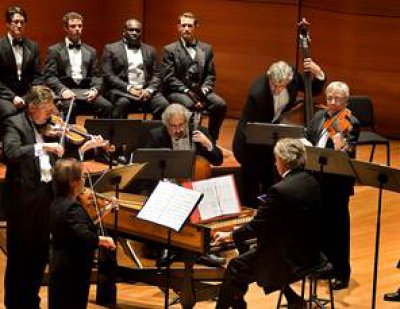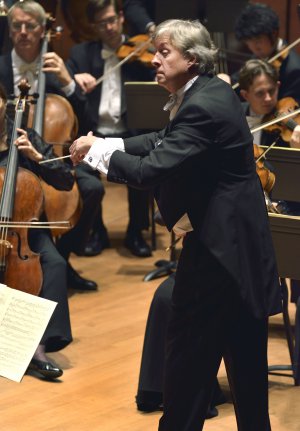American Classical Orchestra: Caldara, Handel, Torelli, and Allegri
An exhilarating and celebratory evening of familiar and unfamiliar Baroque works, all marvelous.
[avatar user=”Jean Ballard Terepka” size=”96″ align=”left” ] Jean Ballard Terepka, Music Critic[/avatar] 2014-2015 was the celebratory thirtieth season of the American Classical Orchestra and Chorus, founded and still directed by Thomas Crawford. It has been a strong year, marked by fine performances of works by Bach, Mozart, Beethoven and Schubert. The April concert of familiar and unfamiliar Baroque works was as exciting and rewarding as Crawford had hoped – in his pre-concert notes and lecture – that it would be.
The program consisted of three fairly short works, an intermission, and then the complete, relatively unknown Maddalena ai piedi di Cristo by Venetian Baroque master Antonio Caldara (1670-1736). The Church of St. Mary the Virgin provided an especially marvelous venue for this concert: the organic warmth of the American Classical Orchestra’s period instruments and the singers’ felicitous precision were exceptionally clear and clean in the high, mysteriously golden American Gothic space of The Church of St. Mary the Virgin in the Times Square area. The concert suffered only one difficulty: it was too long. Some people left starting around the middle of the second half; fortunately, their furtive, tip-toed departure did not disrupt the concentration of the musicians or compromise the performance.
The concert opened with the tenth of George Frideric Handel’s Chandos Anthems, The Lord is My Light. This sunny, spacious piece was performed with openhearted elegance and loveliness; soloists Lawrence Jones and Lianne Coble sang splendidly.
The second piece was Giuseppe Torelli’s Concerto for Trumpet and Strings in D Major. Trumpeter John Thiessen made the difficult music seem airy and sparkling. The entire piece was a magical amalgam of elegance and romp.
The closing piece of the first half was Gregorio Allegri’s famous Miserere Mei Deus. Within the high space of the church, the effect of the two choirs’ far placement from each other was highly effective, making resonances and echoes more complex, but never muddy. The work is best known for the repeated, dazzling high Cs that mark the climax of each of the work’s short movements. The unidentified soprano who carried this line from the rear organ loft of the church had an attractive, strong voice, but she arrived at each of the anticipated high notes by means of a near-raw swoop. Though this throaty style pleases some, it was disconcerting in a performance of the piece otherwise characterized by a very clear sound.
After a twenty minute intermission, the second half of the program began.
Antonio Caldara was once one of the best known and prolific of Italian Baroque composers; now, few but musicologists and academics know his name or his work. This beautiful, rarely heard 1701 Maddalena ai piedi di Cristo is clear demonstration that Caldara should be better known. Maddalena is wonderful. It is inventive; it is both sturdy and delicate. Felicitous harmonies, virtuosic rhythms, surprising, graceful musical turns and unexpected drama also make this a fascinating and thrilling piece.
With a libretto by Lodovici Forni, this Maddalena is an oratorio in which the characters are both human – Mary Madgalene, her sister Martha, Jesus and a Pharisee – and allegorical – Earthly Love and Celestial Love. The “plot” is both minimal and universal: Mary Magdalene must choose whether to remain in a life of luxury, vanity and foolish worldly pleasures or follow God’s invitation to walk in faith towards salvation. There is little narrative. The drama is within the Magdalene’s soul: it is the struggle, at once personal and archetypical, between damnation and salvation.
As with all oratorios in which the audience knows the outcome, the listening experience lies in finding out how the librettist and composer will bring us to the familiar conclusion. We know, here, that Mary’s heart will ultimately be God’s. The brilliance of this Forni-Caldara Maddalena is that we experience Mary’s temptations and uncertainties as Mary experiences them: we do not know the outcome until Mary knows itself.
The human story plays out between Mary Magdalene and her sister, and between a Pharisee and Jesus. The allegorical figures of Celestial and Earthly Love anchor the oratorio in two interconnected traditions. The first of these is the centuries-old conflict between good and evil, sacred and profane, and salvation and sin. The second is the familiar conversion narrative, routinely and regularly replicated in the prototypical stories of saints such as Saul/Paul, many of the early martyrs, St. Augustine and St. Francis. Earthly and Celestial Love are figures that epitomize both vices and virtues on the one hand and the internal psychological drama of temptation on the other: Earthly and Celestial Love are the Magdalene’s interior voices.
The Forni-Caldara writing for the men – the Pharisee and Jesus – is the least interesting in the oratorio. The duplicitous Pharisee is vaguely sinister, more a brittle, pampered casuist than a genuine spiritual threat; Jesus seems more like an earnest high school guidance counselor dispensing sensible advice about good behavior than God incarnate inviting humanity to the soaring infinity of eternal glory. Christopher Herbert (the Pharisee) and Martin Coyle (Jesus) are both fine Baroque singers who brought subtlety and nuance to their roles.
Forni-Caldara’s Martha, sung by Marcy Richardson, is a loving sister, a woman of her own passionate faith and an unwavering certainty that Mary will find her right way. Richardson’s rich, flexible voice was well suited to the warmth and sweet sturdiness of this role.
The allegorical figures, doubling as mirrors of Mary’s psychological conflicts, carry some of the most beautiful writing in the oratorio. Earthly and Heavenly Love have three dazzling duets in which musical inventiveness marks both the depths and the intricacies of the eternal and therefore always contemporary push-and-pull between the sacred and the profane. Solange Meridien (Earthly Love) and Abigail Fischer (Celestial Love) sang gorgeously, both on their own and together. The most exhilarating and powerful music belonged to Earthly Love: recitatives and arias alike made a compelling case for the profane. Earthly Love’s aria, “Orribili, terribili” was marvelously frightening. Meridien and Fischer’s extended debates were thrilling.
All of these singers are regular members of the American Classical Orchestra Chorus; they also have extensive careers as soloists. They are first rate Baroque singers who contributed as much to this marvelous performance as did renowned Czech soprano, Hana Blažíková, who sang Maddalena.
Blažíková has performed this role several times throughout Europe; she has, indeed, become associated with it and has contributed significantly to the greater visibility of this mysteriously and undeservedly underperformed work.
If this performance of Maddalena ai piedi di Cristo “belonged” to Blažíková as well as to the American Classical Orchestra and Chorus it was not because Blažíková is a superior singer – though her artistry is indeed ravishing – but because the character of the Magdalene is the aesthetic center of the piece: her character and her music are both the purpose and the resolution of Caldara’s oratorio. Caldara’s astonishing writing – imaginative and exciting; unexpected, lush and modern; elegant and intelligent; intimate and large – is all turned to the Magdalene’s drama; in Blažíková’s singing, all these overlapping features of Caldara’s writing were shimmeringly clear.
Within the discipline of a highly ornamented Baroque style, Blažíková can make her voice do almost anything: her Maddalena is at every turn authentic not merely because she is such a fine period singer but because her Mary is so credible. We believe each twist and turn of her temptation. We know that she is, finally, free from sin because she knows it. The ethereal delicacy of victory in the Magdalene’s final aria contained the promise for salvation for all of us; her victory is ours because we have lived, with her, through the process of enduring spiritual conversion by means of Earthly and Celestial Loves’ fight for souls.
The April 21 concert was indeed a splendid conclusion to the thirtieth season of the American Classical Orchestra and Chorus. Crawford’s hopes for a brilliant evening were well realized, marred only for those who chose to leave by its excessive length.
American Classical Orchestra: Caldara, Handel, Torelli, and Allegri (April 21, 2015)
The Church of St. Mary the Virgin, 145 West 46th Street, in Manhattan
For more information on ACO’s 2015-2016 season, visit http://www.aconyc.org.
Running time: two hours and 25 minutes including one intermission








Leave a comment